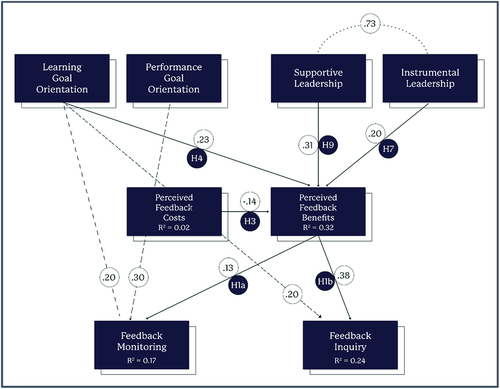Figures & data
Figure 1. A model of medical student feedback-seeking behaviour, modified from Teunissen and colleagues’ model of trainee feedback-seeking behaviour [Citation4]. Arrows indicate hypothesised relationships between predictors, mediators, and outcomes, as follows: hypothesis (H) 1a: feedback benefits are positively associated with feedback monitoring. H1b: feedback benefits are positively associated with feedback inquiry. H2a: feedback costs are negatively associated with feedback monitoring. H2b: feedback costs are negatively associate with feedback inquiry. H3: feedback costs and benefits are negatively associated. H4: learning goal orientation is positively associated with feedback benefits. H5: learning goal orientation is negatively associated with feedback costs. H6: performance goal orientation is positively associated with feedback costs. H7: instrumental supervision is positively associated with feedback benefits. H8: supportive supervision is negatively associated with feedback costs. H9: a positive relationship exists between a more supportive leadership style and perceived feedback benefits.
![Figure 1. A model of medical student feedback-seeking behaviour, modified from Teunissen and colleagues’ model of trainee feedback-seeking behaviour [Citation4]. Arrows indicate hypothesised relationships between predictors, mediators, and outcomes, as follows: hypothesis (H) 1a: feedback benefits are positively associated with feedback monitoring. H1b: feedback benefits are positively associated with feedback inquiry. H2a: feedback costs are negatively associated with feedback monitoring. H2b: feedback costs are negatively associate with feedback inquiry. H3: feedback costs and benefits are negatively associated. H4: learning goal orientation is positively associated with feedback benefits. H5: learning goal orientation is negatively associated with feedback costs. H6: performance goal orientation is positively associated with feedback costs. H7: instrumental supervision is positively associated with feedback benefits. H8: supportive supervision is negatively associated with feedback costs. H9: a positive relationship exists between a more supportive leadership style and perceived feedback benefits.](/cms/asset/36f310ee-0685-4b7c-b028-816cbdc71f53/zmeo_a_2330259_f0001_oc.jpg)
Figure 2. Model explaining final-year medical students’ feedback-seeking behaviours. Reported path values are standardized regression weights. Standardized regression weights < 0.20 are significant at the P < 0.05 level; regression weights ≥ 0.20 are significant at the P < 0.001 level. R2 is the percentage of variance explained for that specific variable. To assess different aspects of the overall model fit, we used several indices including the chi-square index divided by degrees of freedom, which should be less than 3 for a good model fit. The root mean square error of approximation (RMSEA) should be less than or equal to 0.05 and PCLOSE is the corresponding p value that tests the null hypothesis that the RMSEA is no greater than 0.05. The comparative fit index (CFI) compares the covariance matrix of our empirical model to the observed covariance matrix. A CFI close to 1 indicates a very good fit. The fit indices for this model were: chi-square/df = 1.6, RMSEA = 0.043, PCLOSE = 0.54, and CFI = 0.99. The CFI indicates that 99% of the covariance in the data is accounted for by this model. The resulting model explains 2% of the variance on the perceived feedback costs variable, 32% of the variance on perceived feedback benefits, 17% of the variance on feedback monitoring, and 23% of the variance on feedback inquiry.

Figure 3. Diagram of the process used to integrate the data from the mixed methods in this study exploring feedback-seeking behaviours in undergraduate medical students at three transcontinental campuses. FB = feedback. FSB = feedback-seeking behaviours.

Table 1. Participant profile for interviews. Fifty-seven students participated, with their details in terms of gender, entry route (direct entry versus graduate entry), site of study included, with total population numbers for each group also indicated.
Table 2. Means, standard deviations, Cronbach alphas, and correlations among variables in the hypothetical model.
Table 3. Qualitative themes that describe situational factors relating to feedback-seeking behaviours in medical students.
